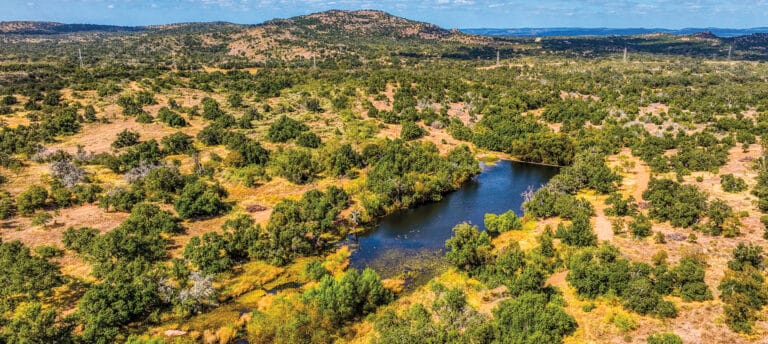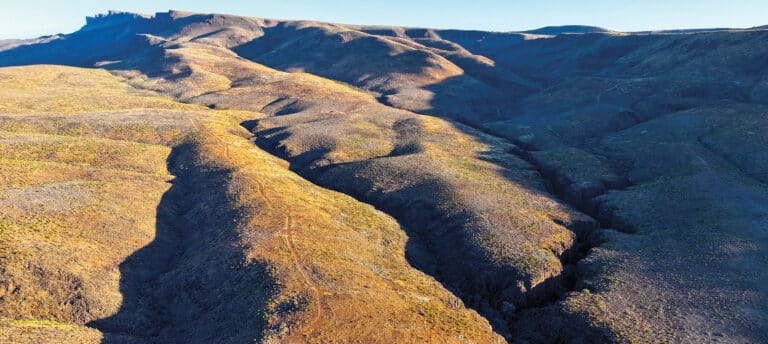
The sultry Texas heat had barely begun to fade. It was late afternoon of the first week in June, and my client and I were overlooking a juniper-studded canyon in Edwards County, scanning the small pockets of open space that were sparsely scattered across the hillsides and along the bottom. A few does and young bucks began emerging from the thicker cover, and I was beginning to think that our chances of laying eyes on a mature male were unlikely on that outing. “Larry, I know we are running out of light, but let’s bail off the side of this hill and check out a water hole that’s down in the bottom of this canyon before it gets dark.” We had no sooner eased to the edge of an opening where we could see the small earthen hole of water when a loud roar from across the canyon broke the late afternoon silence. Larry grabbed my shoulder and asked, “What in the heck was that?” I replied, “It’s a mature axis buck. I’m hoping he is making his way to the water hole.” Seconds later three axis does cautiously made their way toward the water and I instructed Larry to get a comfortable rest across the fork of a dead juniper. The buck stepped into the opening and once again let out a loud roar. “Okay, Larry, he has good tine length, good beams, and fair mass. I suggest you take him if you have an open shot.” The Remington did its job, and minutes later we were admiring a beautifully spotted axis buck. With sweat rolling down his face and a Texas-sized grin, Larry shook my hand and said, “Since reading a magazine article many years ago that Finn Aagaard wrote about axis deer hunting in Texas, I’ve had a dream to experience it myself. I can’t thank you enough for making it happen. Out of all the big game animals I’ve taken around the world, this may be the most beautiful of them all.”
The Animal
Native to India, axis deer were initially released into the Texas wilds back in the 1930s. Referred to as chital in their homeland regions, axis have done well as an exotic in certain areas of the U.S., especially in Texas and Florida. Today, axis deer are in great abundance in certain areas of Texas, found free-ranging in many counties in central Texas, and commonly found on high-fenced game ranches in various regions of the state. Axis are generally not as cold hardy as native whitetails, especially when freezing temperatures are combined with moisture. A mature male may push the scales up to 250 pounds while on the hoof, typically have three points per antler side, and hunters often use main beam length as the central criteria for judging trophy size with 30 inches being the standard that many hunters hold out for, though there are some brutes that may stretch the tape to 35 inches or more. Their reddish colored pelage is laden with white spots, making them a beautiful animal. Axis are often vocal, with males making a strange and loud roaring noise during the rut, and both males and females commonly making a barking noise as an alarm signal. Adding to the attraction of the hunt, axis venison is exceptional table fare, with many people considering it to be among the best of all exotic game meats found in Texas. Concerns are commonly expressed over the impacts that axis deer and other exotic ungulates may have on wildlife habitat and through social conflict with native wildlife species. For certain, there are some ecological downsides of these foreign species being present on other landscapes, but for many private landowners, this exotic resource creates added revenue and recreational opportunities, often incentivizing those landowners to invest money and effort into habitat management, including water development, brush management, seeding of native range plants, and other practices that are often good for the land. As with most landscape practices that involve natural resources, for every action, there are often many reactions, some of which may be good, some not so, while some reactions may simply be subject to biased interpretation.
The Hunt
Though axis deer do not have a synchronized breeding season, the peak of the estrus for females is during the June–July period, which is also the height of when bucks are hard-antlered. Thus, the most popular time to hunt these animals is during the summer, but since some bucks are hard antlered at any given time of the year, it’s common to have axis deer hunting scattered to some degree on a year-around basis. In Texas, since they are an exotic animal, there is no closed season and no bag limits. A non-resident license is only $48 for a 5-day period and is available over the counter. Mature bucks are relatively large bodied animals, with thick musculature frames, so having adequate caliber and bullet type is important. I suggest a minimum of a 130 grain bullet that is well-constructed and not too highly expandable.
The Outfitter
Wildlife Systems, Inc. (WSI) is a hunting and wildlife management firm that was started in 1987. This company conducts axis deer hunts on multiple large private ranches in Texas, with most hunts being scheduled from May through July. These hunts are typically set up as a two or three day hunt, including meals, lodging, guide, and game care. A daily fee is assessed, along with a harvest fee. Hunting is generally a combination of glassing and stalking, as well as some stand-hunting. Lodging is provided on the ranches in comfortable, well-appointed facilities. WSI operates a variety of other exotic and native game hunts on over 900,000 acres of private land in Texas, making it one of the largest and most longstanding hunting companies in the southwestern United States. WSI has also been involved with commercial hunting and wildlife programs in several other states and numerous foreign countries.


